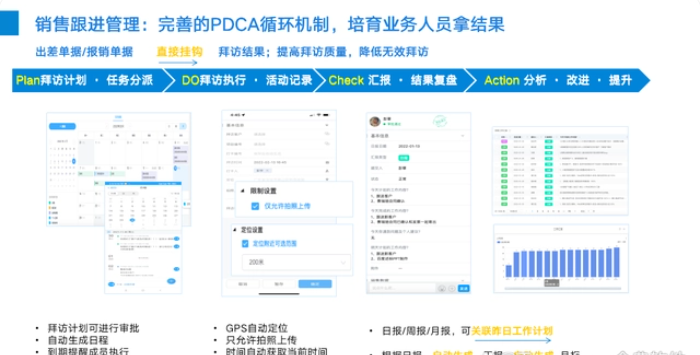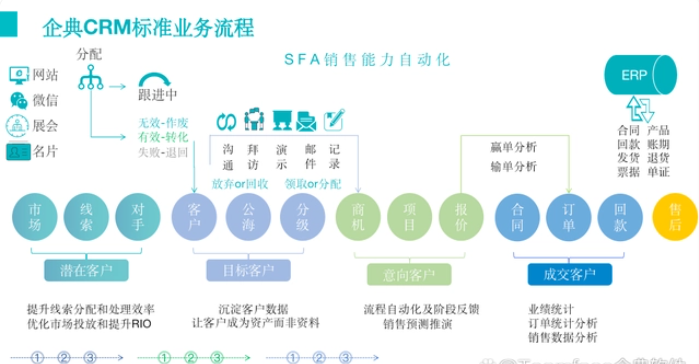What is CRM? Understand its functions and limitations in one article?
CRM stands for Customer Relationship Management in English, which means Customer Relationship Management in Chinese. Customer relationship management is both a management philosophy and a management system. Its significance is to use information science and technology to achieve automated management of the entire process of enterprise marketing, sales, services, etc.

-
Overview of CRM: CRM theory can be summarized as having one central focus, two core points, and three pillars. The central focus is on the customer, the two core points involve detailed customer segmentation and the management of the customer's entire lifecycle, and the three pillars consist of marketing management, sales management, and customer service. CRM helps businesses manage customers more efficiently and enhance customer satisfaction.
-
Specific Functions of CRM Systems:
-
Marketing Management: Conduct customer profile analysis based on different potential customer types, implement targeted marketing campaigns, and enhance customer conversion rates. Systematically analyze customer sources to improve the return on marketing investment.
-
Customer Resource and Public Pool Management: Establish a platform for unified customer information management, allowing for both unified sharing and strict rights division to avoid duplicate entries. Classify customers based on different dimensions and adopt different follow-up and service strategies.
-
Sales Process Management: Manage daily customer follow-up plans, opportunity management, quotation management, contract management, order management, and product management. Establish a one-stop management for the entire sales process and provide a 360-degree customer view to improve customer conversion rates.
-
Customer Service Management: Establish a unified mechanism for the acceptance, allocation, processing, and tracking of customer issues to improve the efficiency of handling customer problems. Also, create a knowledge base for customer service to facilitate self-service inquiries.
-
Customer Behavior Analysis: Collect and analyze customer behavioral data to understand customer preferences and needs, providing precise decision support for businesses.
-
Performance Evaluation and Analysis: Establish a performance evaluation system for customer relationship management, assessing performance in various aspects such as sales and customer service. Adjust and optimize processes in a timely manner.
-
Mobile Office Support: Support mobile devices such as phones and tablets, enabling customer management anytime, anywhere, to improve convenience and efficiency.
-
Data Security and Permission Management: Establish a robust data security and permission management mechanism to ensure the security of customer information while achieving different levels of access for personnel in various positions.
-

-
Sales Personnel Management:
- Team management, visit planning, visit check-ins, sales tasks, daily summaries, schedule management, collaborative reminders, etc. These features help sales teams manage customers more scientifically and efficiently organize team work.
-
Sales Collaboration Management:
- Collaboration on business opportunities, project collaboration, quotation collaboration, contract execution collaboration, order execution collaboration, customer payment/invoice collaboration, etc. This enhances team coordination and efficiency, providing strong support to the sales team and boosting competitiveness.
-
Sales Performance Management:
- Sales goals, sales plans, performance achievement, performance assessment, commission calculation, sales profit, performance forecasting, performance rankings, etc. This results-oriented approach promotes healthy competition within the team and contributes to the overall development of the business.
-
Expense Control:
- Expense reimbursement limits, expense reimbursement approval, sales cost accounting, profit analysis, etc. This helps businesses control costs effectively, ensuring profitability on orders.
-
Business Process Management:
- Business opportunity/project processes, quotation processes, contract execution processes, order execution processes, customer service processes, expense reimbursement processes, etc. These streamline team collaboration, reduce communication and training costs, prevent errors, and enhance overall collaboration efficiency.

-
After-Sales Service Management:
- Customer complaint applications, acceptance and follow-up, process follow-up, results feedback, satisfaction surveys, customer follow-ups, customer care, etc. This enhances the efficiency of the entire customer complaint process, improves service quality, and increases customer satisfaction.
-
Intelligent Reminders:
- Task assignment reminders, customer follow-up reminders, contract expiration reminders, payment reminders, invoicing reminders, customer birthday reminders, schedule reminders, approval reminders, etc. Intelligent assistants provide timely reminders for every important moment, preventing the oversight of crucial events.
-
BI Data Analysis/Management Dashboard:
- Return on investment analysis, sales funnel analysis, sales forecasting, sales reports, performance reports, customer segmentation reports, business opportunity conversion rates, sales payment analysis, customer value analysis, cost and expense analysis, customer complaint analysis, product sales analysis, etc. This provides real-time and accurate data support for businesses, aiding decision-makers in making informed decisions.

Overview of CRM:
CRM theory can be summarized as having one center, two core points, and three pillars. The one center is customer-centricity, the two core points involve detailed customer segmentation and full lifecycle management, and the three pillars encompass marketing management, sales management, and customer service. CRM helps businesses manage customers more efficiently and enhance customer satisfaction.
Specific Functions of CRM Systems:
-
Marketing Management:
- Analyzing customer profiles based on different potential customer types.
- Targeted marketing promotions to improve customer conversion rates.
- Systematic analysis of customer sources to enhance marketing ROI.
-
Customer Resource and Open Pool Management:
- Establishing a unified platform for managing customer information.
- Classifying customers based on different dimensions and implementing varied follow-up and service strategies.
-
Sales Process Management:
- Daily customer follow-up plans.
- Opportunity management, quotation management, contract management, and order management.
- Comprehensive sales process management and 360-degree customer inquiries.
-
Salesperson Management:
- Team management, visit plans, visit check-ins, sales tasks, daily summary reports, schedule management, and collaborative reminders.
-
Sales Collaboration Management:
- Collaboration on business opportunities, quotation, contract execution, order execution, customer payment/invoicing, etc.
- Enhancing team coordination and efficiency, boosting the sales team with robust support.
-
Sales Performance Management:
- Sales goals, sales plans, performance achievements, performance assessments, commission calculations, sales profits, performance forecasts, and performance rankings.
- Results-oriented promotion of healthy team competition.
-
Expense Control:
- Expense reimbursement limits, expense reimbursement approvals, sales cost accounting, profit analysis, etc.
- Effective cost control to ensure order profitability.
-
Business Process Management:
- Opportunity/project processes, quotation processes, contract execution processes, order execution processes, customer service processes, expense reimbursement processes, etc.
- Tighter team collaboration, reduced communication and training costs, and avoidance of errors to enhance overall cooperation efficiency.
Limitations of CRM Systems:
In our experience with client cases, it's found that relying solely on CRM systems is insufficient to provide excellent customer service and boost conversion rates. The completion of projects or orders involves collaboration across multiple departments within the enterprise. A single CRM system cannot fully meet these complex collaboration requirements, highlighting the need for a higher-level, integrated approach.
Solutions and Implementation Approaches:
The survival of a business depends on overall sales performance and profitability. Thus, an enterprise must establish a business-centric management system with a focus on sales. The next steps involve breaking down how to apply a system to achieve an integrated management approach for the entire enterprise.

-
Strategic Goal Management Software - Qidian CRM
Qidian CRM software is a comprehensive solution that focuses on strategic goal management with the centralization of business objectives. Here are the key features and advantages of this software:
-
Goal Management System:
- It allows for the systematic breakdown of enterprise business objectives into team and individual levels.
- Real-time monitoring of goal realization paths and progress ensures transparency and easy control.
-
Talent Competency Model Software:
- It establishes standardized, scientific, uniform, and practical talent selection, appointment, promotion, and succession mechanisms based on different position competency requirements.
- Assists enterprises in building a talent succession pipeline, ensuring timely elimination of unqualified personnel without dependence on individual contributors.
-
Sales Goal-Oriented Integration with Performance Indicators:
- Ensures that performance assessment indicators are closely related to enterprise and individual goals, unifying team objectives.
- Aligns individual performance targets with company-wide objectives to prevent situations where departmental goals are achieved while company objectives remain unfulfilled.
-
Establishment of Rank System and Corresponding Compensation Structure:
- Associates employee performance results directly with rank promotion or demotion, where remuneration varies based on different ranks for the same position.
- Motivates employees by clearly illustrating the consequences of not meeting job requirements, including potential demotion and salary reduction.
-
Creation of Employee Promotion Channels:
- Defines development pathways and trajectories for each position, providing employees with a clear map for career advancement.
- Reinforces a long-term commitment to employee growth by outlining the skills and qualifications required for desired rights and salaries.
-
Establishment of Bonus Pool and Distribution System:
- Ensures that project completion or annual performance targets lead to proportional rewards.
- Implements a distribution mechanism based on the percentage of contributions, motivating participants to perform at their best.
Qidian CRM: Your Tailored Solution for Digitalized Management
As an implementation manager, Qidian CRM software offers a perfect fit for the functionalities mentioned above. Since 2012, we have been dedicated to providing businesses with comprehensive solutions that seamlessly integrate with their needs. Leveraging Silicon Valley's low-code development technology, we enable swift customization of enterprise systems, ensuring software aligns with company requirements and maximizes its value. Our primary goal is to facilitate cost-effective digitalized management for businesses.
-





